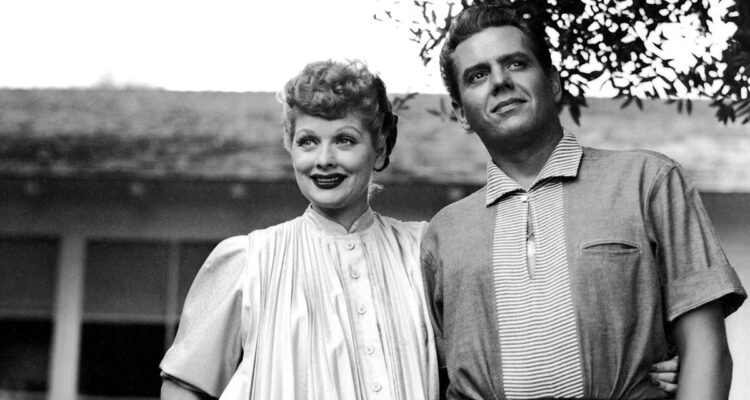There is, at the moment, no shortage of information in the culture about Lucille Ball and Desi Arnaz. In just the past few months, the performers behind “I Love Lucy” have been the subjects of both a (very good) season of TCM’s “The Plot Thickens” podcast and a (very bad) Aaron Sorkin movie, “Being the Ricardos.” Now you can add to that mix “Lucy and Desi,” a new feature-length bio-documentary from actor/director Amy Poehler, which is hitting Amazon Prime in March, presumably as something of a companion piece to “Ricardos” (which the streamer/studio also financed). Because it arrived in the marketplace last, “Lucy and Desi” can feel a bit repetitive, particularly since all three works contain many of the same stories, anecdotes, and legends. But for those looking for a quick fix or a streamlined explanation of these people and their influence, it gets the job done.
READ MORE: Sundance 2022 Preview: 20 Must-See Movies From The Festival
Because they lived so much of their lives in the public eye, the voluminous available audio – interviews, conversations, taped diaries – allows Ball and Arnaz to tell their own story, which is a real advantage. As the film’s director, Poehler also prioritizes one aspect of their story above all. “At the core, it’s all about unconditional love,” explains their daughter, Lucie Arnaz Luckinbill. So while there’s much to learn here about their backgrounds, about the film and television industries, and about American life in the 1950s, “Lucy and Desi” is mostly a story abut two beautiful people who fell in love and, despite a tempestuous marriage and very public divorce, never quite fell out of it.
The film begins with Lucy’s story, returning to her upbringing in her hometown of Jamestown, New York, and following her to New York and then Hollywood, where her strategy was simple: “When you’re not beautiful, and you’re not too bright, you try to get attention any way you can.” She was enjoying a successful but unremarkable career in B-movies at RKO when she met Arnaz, a Cuban musician and fellow contract player. The two would go on to a whirlwind romance and marriage, but the demands of their careers kept them from creating a sense of a shared home or starting the family they both wanted. To change this, Ball leveraged her success to allow them to work together, insisting that the television version of her domestic radio comedy, “My Favorite Husband,” co-star her real-life husband.
“Lucy and Desi” offers up well-told tales of “I Love Lucy” lore: the groundbreaking onscreen pregnancy, the Red scare that nearly derailed the show and their lives (the primary subject of “Being the Ricardos”), and the technical innovations that Desi (who turned out to be a brilliant television producer and executive) oversaw, and which became the industry standard. The backstage politics of the show and the mechanics of its production have fascinated fans and historians for decades, and there’s much of that here. But keeping her eye on the ball, Poehler focuses on how this close collaboration exacerbated the diverging drives that would ultimately lead to the couple’s split. Simply put, Lucy liked to work too much, and Desi liked to play too much. Yet they stayed close, even after the divorce (in fact, Arnaz produced Ball’s subsequent solo sitcom), and the film finds its emotional center in Luckinbill’s memories of their interactions during Desi’s last days, as well as an extraordinary bit of footage from Ball’s Kennedy Center induction.
The filmmaking isn’t particularly innovative, but it’s effective. Poehler and editor Robert A. Martinez assemble the expected assortment of materials: home movies, promo clips, behind-the-scenes footage, and, of course, numerous clips from their beloved series. The latter are especially well-chosen, serving as a nice reminder that, contrary to one current filmmaker’s opinion, “I Love Lucy” remains a very funny show. (Admirers of “Being the Ricardos,” and I’ve been assured there are some, will particularly enjoy clips here of the awkward double-dinner-date scene in “I Love Lucy” that served as a centerpiece of that film.) There are also testimonials, mostly from those whom Ball admired and mentored: Carol Burnett, Bette Midler, Norman Lear, and…Charo?
But the most successful material is that which most readily bears the markers of Poehler’s personality and interests. Early on, we’re told about Ball’s “scientific approach to what generates a laugh,” and in an archival interview, Ball insists, “You don’t necessarily have to be a funny person to get a laugh. I’m not a funny person.” But she studied comedy – timing, blocking, reaction, photography – tirelessly, and in the process developed a keen understanding of its mechanics.
The filmmakers take pains to include contemporary perspectives (most often articulated by interview subject and media historian Laura LaPlaca) on how Ball and her work were perceived and received. “As a woman, you had to be really good, because it wasn’t always going to be embraced,” LaPlaca explains, and there is much to consider about how Ball functioned and worked as a woman in an almost exclusively male-driven industry – how hard-nosed she had to be after all those years in the business, and how that single-mindedness and dedication translated into labels like “difficult” and “stubborn” as well as phrases like “she came on pretty strong.” Those explorations work so well that you almost wish Poehler had ditched the bio-doc format altogether and made more of a free-form video essay on what Ball did and how she did it.
As it is, “Lucy and Desi” is a well-made bio-doc. The score is sturdy, Martinez’s cutting is snazzy, and – much like the rhythmic musicality of Questlove’s “Summer of Soul” – you get a sense of Poehler’s energy in the fast pace and comic timing of film, which moves at a good, precise clip. There’s a lot of material to cover here, some of it overly familiar, but Poehler does it with pizzaz. [B]
Read along with all our coverage of the 2022 Sundance Film Festival

